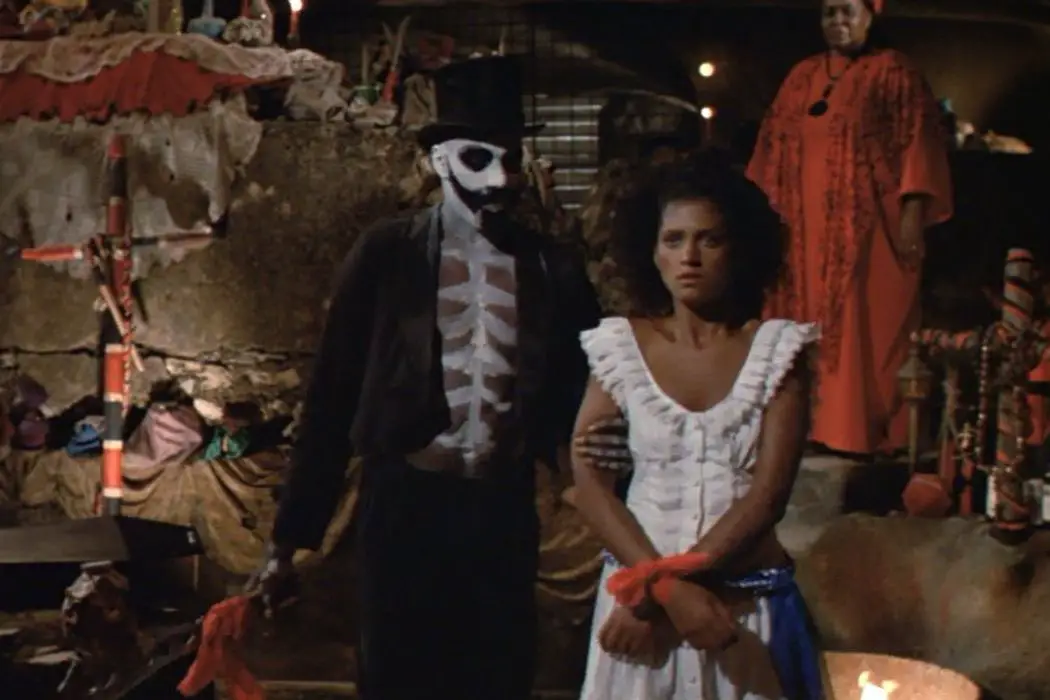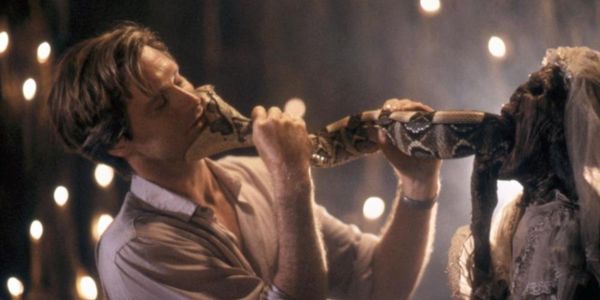THE SERPENT AND THE RAINBOW: 30 Years Later

Michelle Sabato is an actor and writer from Cleveland, Ohio.…
As a child I was not allowed to watch scary movies. My mother was fully aware that I was a sensitive child who scared far too easily. But I had a cousin who was eighteen months older than me and she watched horror films all the time. So, naturally, I wanted to do whatever she was doing. My mother eventually relented and the I went for some heavyweights: The Serpent and the Rainbow and The Exorcist.
Yes, I know what you’re thinking: “Why would you go for the scary movies with religious elements if you were raised Catholic and are superstitious?” What can I say, I live on the edge! In all actuality, I ended up having to sleep in my mothers bed for many months after my horror movie experience. I have no shame in admitting that.
While both films left an impact on me that manifest as night terrors from time to time, The Serpent and the Rainbow also showed me a culture that was foreign and ultimately intriguing.
The Serpent and the Rainbow
Dr. Dennis Alan, played by Bill Pullman, is asked by a pharmaceutical company to go to Haiti and research a case of a man named Christophe. Christophe had died in the 1970s, but was reported to be alive and well after his burial. The pharmaceutical company got word that a voodoo ritual was performed on Christophe and they want Dr. Alan to find what was used in order to replicate it and bring it back to the United States.

As Alan spends more time among the people, he learns that the voodoo rituals are all too real. He will be threatened by the Haitian paramilitary group, Tonton Macoute; specifically Captain Paytraud, who has also appeared in many of Alan’s dreams. It is later revealed that Paytraud is actually a bokor, or sorcerer. But Alan refuses to give up his mission and stays, even though it almost costs him his life.
After being sprayed with the zombie powder, Alan’s body is taken to the graveyard before his death could be reported to the authorities. Alan is buried alive, but is rescued by Christophe who lives in the cemetery. Alan goes and defeats Paytraud and the Haitian people celebrate as the government is overthrown and their nightmarish times come to an end.
Historical Relevance
The film is based on the findings of Harvard scientist Wade Davis. He was deeply seeped into the voudon culture, which he came to realize was just an extension of the Haiti culture: the roots starting in Africa and spreading into the Caribbean.
There was a particular instance that led Davis to make his travel. In the film it is Christophe, but in real life there was a Haitian man named Clairvius Narcisse. Clairvius had fallen ill, died and was buried. Years later Clairvius’s sister, Angelina, was shopping in a local market when she screamed out in terror. Clairvius was standing right in front of her, many years after his burial. Yes, zombies are real! No, in fact, it was something more sinister. Clairvius had been arguing with his brother, and his brother had him poisoned by a local shaman, who mixed toxins from a toad and pufferfish that put him in a zombie like state and mimicked signs of actual death. Davis traveled to Haiti to learn the meanings behind these sort of spells and concoctions.

Another historical element that played a factor in this film was the real life turmoil that was occurring while filming. The film was originally slated to shoot on location in Haiti, but the government could not guarantee the safety of the crew. So they were forced to pick up and shoot the rest of the film in the Dominican Republic. The cast and crew got a first hand look of the government upheaval that the film depicts. As supernatural elements played a part in the horror of this film, the real life government regime of Haiti also caused panic to the filming.
Simplistic Horror
I am in no way an expert on the horror genre, but I can tell you what makes this film appealing to me. First, it was directed by Wes Craven, a true father of the horror genre. In the trailer to this film, it touts “From Wes Craven, Director of A Nightmare on Elm Street“. This was his follow up to A Nightmare on Elm Street, and while it might not have had as a large of a following, it definitely holds rank as a horror classic. For me, I prefer The Serpent and the Rainbow to A Nightmare on Elm Street because it is based on actual events, which make it all the more scary. The film also gave people of color and a Caribbean culture a spotlight, even if it was a creepy one. What this film did, that Craven’s other works did not, was expose it’s audience to something new by way of culture and religion.

Juxtaposing the voodoo horror with the real life horror of the Haitian government was also an important part of the film. The human rights violations that occurred under the Haitian regime at the time was appalling, so freeing the people of the government while also ridding them of the bokor was apropos.
It’s also worth noting that this film gave zombies a more life like quality. That’s kind of an oxymoron, but you know what I mean. The notion that zombies could actually exist seems like a farcical notion, but then you watch this film and it doesn’t seem so far fetched. Zombies in this film are not like the zombies in more recent film and television depictions; no limbs are falling off and their faces are not sunken with eyes bulging. In fact, if you think of what would be scarier, would it be the zombies we’ve seen more recently, or the ones like in The Serpent and the Rainbow who appear to be “normal” people, but you know are dead because you’ve been to their funeral?
Conclusion
I might be a wuss when it comes to horror films, but at least I can say that I appreciate the classics. And The Serpent and the Rainbow is a classic to me. Mixing religious beliefs with real life zombies is a mixture that could have turned hokey real quick. And adding the political strife into the plot made the story somehow relatable or at least identifiable.
I always enjoy a film where I’m learning something new, and The Serpent and the Rainbow gave that to me. Never mind that I completely embarrassed myself once by asking a Haitian girl I met in college if she could get puffer fish juice…Yes, she looked at me like I lost my mind and I felt like a fool for asking. But, do you enjoy films where you learn about different cultures? This being one of Wes Craven’s films, why do you think it wasn’t as popular as some of his others?
Is The Serpent and the Rainbow one of your favorite Wes Craven features? Let us know in the comments!
Does content like this matter to you?
Become a Member and support film journalism. Unlock access to all of Film Inquiry`s great articles. Join a community of like-minded readers who are passionate about cinema - get access to our private members Network, give back to independent filmmakers, and more.
Michelle Sabato is an actor and writer from Cleveland, Ohio. By the age of 2 Michelle had memorized all the words to The Wizard of Oz. So, yes, she can carry a conversation with just using movie quotes.













